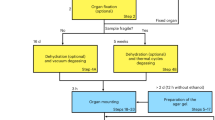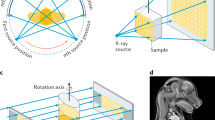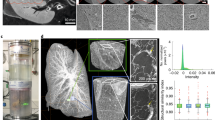Abstract
Conventional high–resolution X–ray computed tomography (XCT) is an important medical technique because it provides sectional images (tomograms) of internal structures without destroying the specimen. However, it is difficult to observe and to analyze fine structures less than a few cubic millimeters in size because of its low spatial resolution of 0.4 mm. Overcoming this problem would not only enable visualization of human anatomical structures in living subjects by means of computer images but would make it possible to obtain the equivalent of microscopic images by XCT without making microscopic sections of biopsy material, which would allow the examination of the entire body and detection of focal lesions at an early stage. Bonse et al. and Kinney et al. studied absorption contrast microtomography by using synchrotron radiation1–3 and achieved 8–μm spatial resolution in human cancellous bone1. Recently, Momose et al. reported examining the soft tissue of cancerous rabbit liver by a modification of the phase–contrast technique using synchrotron radiation with a spatial resolution of 30 μm (ref. 4). However, the equipment for synchrotron radiation requires a great deal of space and is very expensive. Aoki et al., on a different tack, reported microtomography of frog embryos by using a conventional laboratory microfocus X–ray source with a spot size of about 2 μm (ref. 5). As no human tomographic studies by superresolution microfocus XCT (MFXCT) using a normal open–type X–ray source have been reported, we tried using MFXCT with a maximum experimental spatial resolution of 2.5 μm, especially designed for industrial use, on the auditory ossicles6 of a human fetus, the smallest and lightest bones in the skeletal system. No XCT studies of fetal auditory ossicles have been reported to date. The fine tomograms with three–dimensional reconstructions obtained showed the existence of an apparently previously undescribed joint between the tympanic ring and the anterior process of the malleus. We hope the early development of this MFXCT for clinical use will make a great contribution to medicine.
This is a preview of subscription content, access via your institution
Access options
Subscribe to this journal
Receive 12 print issues and online access
$209.00 per year
only $17.42 per issue
Buy this article
- Purchase on Springer Link
- Instant access to full article PDF
Prices may be subject to local taxes which are calculated during checkout
Similar content being viewed by others
References
Bonse, U. et al. 3D computed X-ray tomography of human cancellous bone at 8 microns spatial and 10−4 energy resolution. Bone Miner. 25, 25–38 (1994).
Kinney, J.H. et al. The X-ray tomographic microscope: Three-dimensional perspectives of evolving microstructures. Nucl. Instrum. Methods Phys., Res. Sect. A, Accelerators Spectrometers Detectors Assoc. Equip. 347, 480–486 (1994).
Kinney, J.H. et al. High-resolution CT system for elemental mapping. 26th Society of Photographic Scientists and Engineers Fall Symposium and Fifth International Conference and Exposition on Electronic Imaging, Arlington, Virginia, October 5, 1986. (Livermore Natl. Laboratory, Livermore, California, & Dortmund Univ., Germany, 1986, available through NTIS).
Momose, A., Takeda, T., Itai, Y. & Hirano, K., Phase-contrast X-ray computed tomography for observing biological soft tissues. Nature Med. 2, 473–475 (1996).
Aoki, S., Yoneda, I., Nagai, T., Ueno, N. & Murakami, K., Nondestructive Imaging of internal structures of frog (Xenopus laevis) embryos by shadow-projection X-ray microtomography. Jpn. J. Appl Phys. 33, L556–L558 (1994).
Kubik, St. Verbindungen und Bewegungen der Gehörknöchelchen. in Rauber/Kopsch Anatomic des Menschen Band. III. Nervensystem Sinnesorgane (eds. Leonhardt, H., Tillmann, B., Töndury, G. & Zilles, K.) 588–601 (Thieme, Stuttgart, 1987).
Barry, J.A. Auditory ossicles. in Morris' Human Anatomy: A Complete Systematic Treatise, 12th edn. (ed. Barry, J.A.) 1186–1191 (McGraw-Hill, New York, 1966).
Hinrächsen, K.V. Mittelohr in Ohrentwicklung. in Humanembryologie Lehrbuch und Atlas der vorgeburtlichen Entwicklung des Menschen (ed. Hinrichsen, K.V.) 509–512 (Springer, Berlin, 1990).
Slavkin, H.C. The development of the ear. in Developmental Craniofacial Biology (ed. Slavkin, H.C.) 373–377 (Lea & Febiger, Philadelphia, 1979).
Vesalius, A. De Humani Corporis Fabrica Librorum Epitome (Basel, 1543).
Swartz, J.D. High-resolution computed tomography of the middle ear and mastoid. Radiology 148, 449–454 (1983).
Bracewell, R.N. et al. The inversion of fan-beam scans in radioastronomy. Astrophys. J. 150, 427–434 (1967).
Sato, Y. Morphological studies on auditory ossicles of the Japanese. J. Otolaryngol. Jpn. 59, 953–961 (1956).
Author information
Authors and Affiliations
Rights and permissions
About this article
Cite this article
Shibata, T., Nagano, T. Applying very high resolution microfocus X–ray CT and 3–D reconstruction to the human auditory apparatus. Nat Med 2, 933–935 (1996). https://doi.org/10.1038/nm0896-933
Received:
Accepted:
Issue Date:
DOI: https://doi.org/10.1038/nm0896-933



